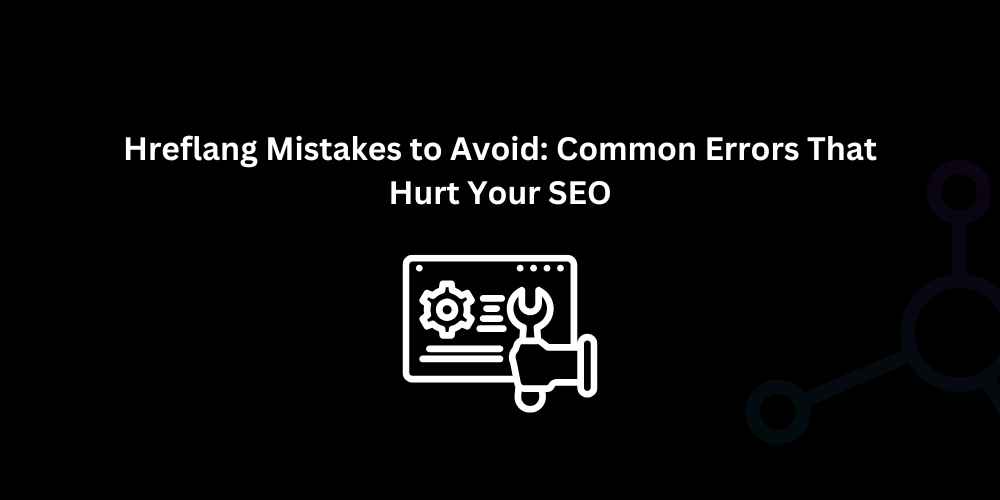
When optimizing your website for international audiences, hreflang tags are a powerful tool for signaling search engines about the intended language and region of your content. However, a small misstep in implementing hreflang tags can hurt your SEO performance. This guide outlines the most common hreflang mistakes and how to avoid them, ensuring your website ranks effectively across multiple regions.
What Are Hreflang Tags and Why Are They Important?
Hreflang tags help search engines understand which version of your webpage to show to users based on their language and location. Without them, users might land on a version of your website that doesn’t suit their language preferences, resulting in a poor user experience and higher bounce rates.
Common Hreflang Mistakes to Avoid
1. Mismatched or Missing Hreflang Annotations
One of the most frequent errors is forgetting to set up reciprocal hreflang annotations. For example, if Page A references Page B as its alternate, Page B must also reference Page A. Failing this can confuse search engines and diminish the effectiveness of your hreflang tags.
Fix: Double-check all hreflang annotations to ensure they are reciprocal.
2. Incorrect Language and Region Codes
Using incorrect ISO 639-1 language codes or ISO 3166-1 alpha-2 region codes can make your hreflang tags invalid. For instance, using “en-UK” instead of the correct “en-GB” is a common mistake.
Fix: Refer to Google’s hreflang guidelines to use the correct codes.
3. Pointing Hreflang Tags to Nonexistent Pages
Broken links in hreflang annotations can lead to wasted crawl budgets and hurt your SEO.
Fix: Regularly audit your hreflang tags to ensure they point to live, functioning pages.
4. Using Hreflang Tags in HTTP Headers Improperly
While it’s possible to use hreflang tags in HTTP headers, doing so incorrectly can cause issues with search engine crawlers.
Fix: Use hreflang in HTML tags for most scenarios unless you’re serving non-HTML files like PDFs.
5. Not Accounting for Canonical Tags
Hreflang tags should always align with canonical tags. A mismatch can signal conflicting instructions to search engines, diluting your SEO impact.
Fix: Ensure that hreflang annotations match the canonical URL for each language or regional variant.
6. Relying on Automated Hreflang Implementation Without Validation
Tools and plugins can make hreflang implementation easier, but they’re not foolproof. Automated setups often generate errors that go unnoticed.
Fix: Manually validate hreflang tags using tools like Google’s URL Inspection or Hreflang Checker.
7. Ignoring Mobile and Desktop URL Differences
If you have separate URLs for mobile and desktop versions of your site, your hreflang tags must reflect this distinction.
Fix: Specify hreflang annotations for both mobile and desktop URLs.
How Hreflang Errors Hurt SEO
Errors in hreflang implementation can lead to:
- Incorrect indexing: Google might display the wrong version of your page.
- High bounce rates: Visitors landing on irrelevant pages are likely to leave quickly.
- Wasted crawl budget: Search engines expend resources indexing invalid hreflang annotations.
How Techno Digital Can Help You Optimize Hreflang Tags
At Techno Digital, we specialize in advanced SEO strategies, including seamless hreflang tag implementation. Our team ensures your international SEO efforts drive results by:
- Conducting thorough hreflang audits.
- Validating tags for accuracy and compliance with Google guidelines.
- Using data-driven strategies to improve multilingual and multi-regional visibility.
With our expertise, your website will reach its intended audience across the globe.
Conclusion
Avoiding hreflang mistakes is crucial for successful international SEO. By addressing these common errors, you’ll improve user experience, lower bounce rates, and ensure search engines display the right content to the right audience.
For flawless hreflang tag implementation and other advanced SEO solutions, choose Techno Digital—your partner for global SEO success.




